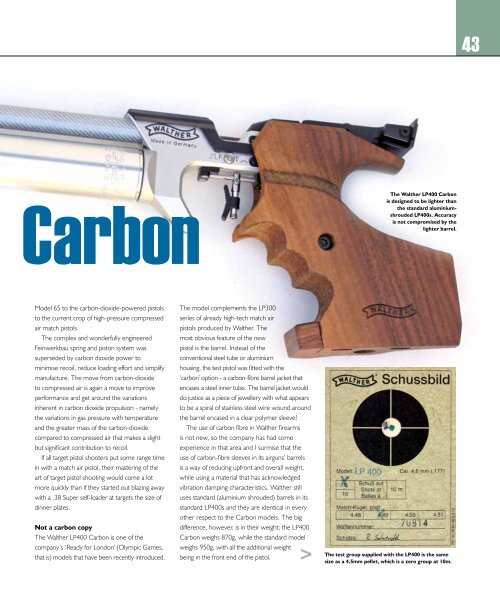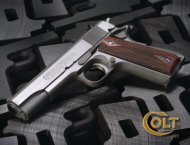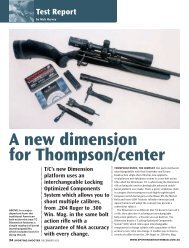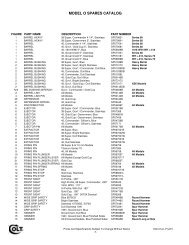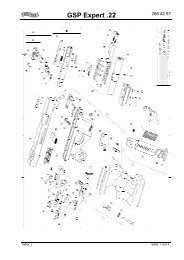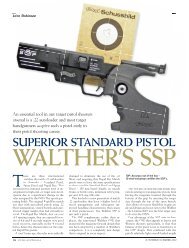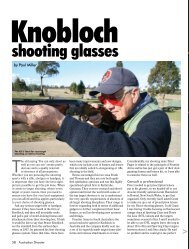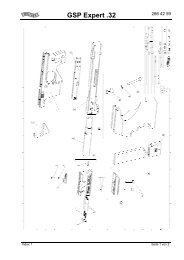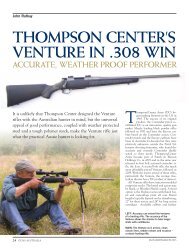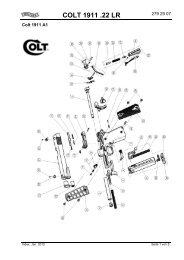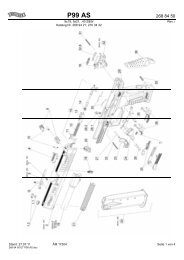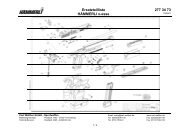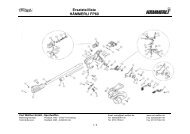Air apparent - Walther's LP400 Carbon - Frontier Arms
Air apparent - Walther's LP400 Carbon - Frontier Arms
Air apparent - Walther's LP400 Carbon - Frontier Arms
Create successful ePaper yourself
Turn your PDF publications into a flip-book with our unique Google optimized e-Paper software.
43<br />
<strong>Carbon</strong><br />
The Walther <strong>LP400</strong> <strong>Carbon</strong><br />
is designed to be lighter than<br />
the standard aluminiumshrouded<br />
<strong>LP400</strong>s. Accuracy<br />
is not compromised by the<br />
lighter barrel.<br />
Model 65 to the carbon-dioxide-powered pistols<br />
to the current crop of high-pressure compressed<br />
air match pistols.<br />
The complex and wonderfully engineered<br />
Feinwerkbau spring and piston system was<br />
superseded by carbon dioxide power to<br />
minimise recoil, reduce loading effort and simplify<br />
manufacture. The move from carbon-dioxide<br />
to compressed air is again a move to improve<br />
performance and get around the variations<br />
inherent in carbon dioxide propulsion - namely<br />
the variations in gas pressure with temperature<br />
and the greater mass of the carbon-dioxide<br />
compared to compressed air that makes a slight<br />
but significant contribution to recoil.<br />
If all target pistol shooters put some range time<br />
in with a match air pistol, their mastering of the<br />
art of target pistol shooting would come a lot<br />
more quickly than if they started out blazing away<br />
with a .38 Super self-loader at targets the size of<br />
dinner plates.<br />
Not a carbon copy<br />
The Walther <strong>LP400</strong> <strong>Carbon</strong> is one of the<br />
company’s ‘Ready for London’ (Olympic Games,<br />
that is) models that have been recently introduced.<br />
The model complements the LP300<br />
series of already high-tech match air<br />
pistols produced by Walther. The<br />
most obvious feature of the new<br />
pistol is the barrel. Instead of the<br />
conventional steel tube or aluminium<br />
housing, the test pistol was fitted with the<br />
‘carbon’ option - a carbon-fibre barrel jacket that<br />
encases a steel inner tube. The barrel jacket would<br />
do justice as a piece of jewellery with what appears<br />
to be a spiral of stainless steel wire wound around<br />
the barrel encased in a clear polymer sleeve!<br />
The use of carbon fibre in Walther firearms<br />
is not new, so the company has had some<br />
experience in that area and I surmise that the<br />
use of carbon-fibre sleeves in its airguns’ barrels<br />
is a way of reducing upfront and overall weight,<br />
while using a material that has acknowledged<br />
vibration damping characteristics. Walther still<br />
uses standard (aluminium shrouded) barrels in its<br />
standard <strong>LP400</strong>s and they are identical in every<br />
other respect to the <strong>Carbon</strong> models. The big<br />
difference, however, is in their weight; the <strong>LP400</strong><br />
<strong>Carbon</strong> weighs 870g, while the standard model<br />
weighs 950g, with all the additional weight<br />
being in the front end of the pistol.<br />
><br />
The test group supplied with the <strong>LP400</strong> is the same<br />
size as a 4.5mm pellet, which is a zero group at 10m.


